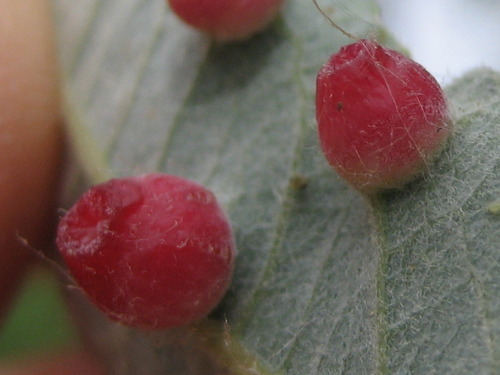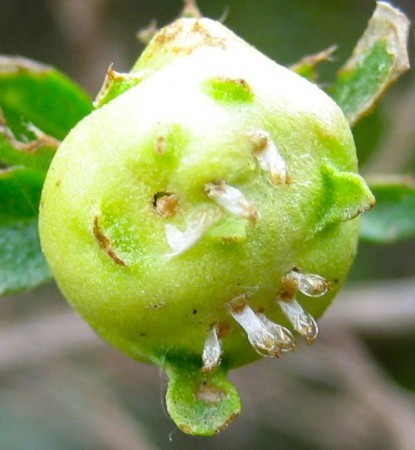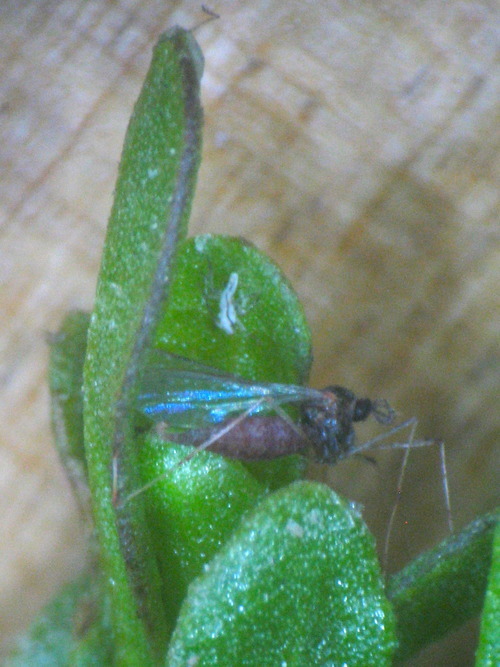Insects associating with coyote brush (Baccharis pilularis) at…
Monday, February 9th, 2015Insects associating with coyote brush (Baccharis pilularis) at the Carpinteria Salt Marsh, February 8, 2015.
My search for a Rhopalomyia californica emergence event continues. I’ve read that the adults, which only live a few hours, tend to emerge in the morning after a rain. It rained last Saturday, so on Sunday morning I went to the marsh hoping to catch them in the act. These photos show some of the bug-related things I found. (A companion post has non-bug-related pictures.)
I found a lot of galls, more than I’ve seen at any time since last year’s drought knocked their numbers down.
First row:
I didn’t find any R. californica galls with adults in the process of emerging, but I did find some with evidence of recent emergence. The first three photos above show what that looks like. First is a shot of my hand holding a gall to give a sense of scale. (Hopefully I’m not helping biometric-identity thieves by posting a photo of my fingerprints.) Next is a closeup of the same gall showing the leftover exuvia of several emerged adults, and finally an even closer shot of exuvia from a different gall.
I’m not sure how long the exuvia (which are the spent pupal case) remain on the surface of the gall, but I’m guessing it’s at least a few months. If I did a better job of monitoring individual galls over time, rather than just wandering through the marsh observing them on a particular day, I probably could answer that question.
Second row:
Most of the R. californica galls in the marsh are green or yellowish-green, but a few of them are magenta. I have no idea why that is. I’m not aware of any non-gall-related structures on coyote brush with that color. The biochemical/genetic interactions between gall-inducing species and their host plants are quite mysterious, especially to a layperson like me. I wonder if the magenta galls have different properties aside from color. Are they thicker-walled? Do they represent a genetic variation in the gall inducer, or are they just a more-or-less random result of the particular site on the plant where the adult midge lays its eggs?
The righthand image shows the gall of a different Rhopalomyia species, R. baccharis. This is what Russo (who first described the species) calls the “twisted stem gall”. The adult insect is indistinguishable from R. californica except by genetic analysis, but the gall is completely different. Instead of a fleshy round gall containing several larvae at the tip of a stem, R. baccharis creates a thickening of the plant stem that has a characteristic series of S-curves, with one larval chamber below each bend. This isn’t a very good shot of the gall itself, but it shows the gall’s characteristic elliptical emergence hole. That hole isn’t created directly by the larva; instead, there is some sort of communication that takes place between larva and plant that triggers the plant to create that opening at the time the larva pupates, clearing the way for emergence.
I wonder if there are advantages to developing inside the coyote brush’s stem rather than in a bud gall. The outer covering of stem galls is tougher, which I’m guessing helps protect the larvae from the ovipositors of parasitoid wasps. But that also means the larvae’s jaws probably aren’t adequate for chewing their way out, the way R. californica larvae do. It’s mind-boggling to think about the shared coevolutionary history between plant, gall inducer, and predators/parasitoids that led to the current situation.
Third row:
Here’s a photo of another one of my favorite coyote brush galls, that of the moth Gnorimoschema baccharisella. I didn’t notice it while taking the photo, but I think those may be two more G. baccharisella galls growing at the tips of the stems to the left and right of the large gall, with a fourth one visible in the photo’s lower righthand corner. My guess is that those are all from a single egg-laying session; unlike Rhopalomyia galls, G. baccharisella galls are monothalamous, meaning there is only one larva per gall.
The middle photo shows some kind of hide constructed from a number of leaves stuck together. I don’t have any idea what made it, and didn’t want to tear it apart to try to find out. I’m going to post my photos of it to Bugguide and see what Charley Eiseman thinks.
Finally, the Trirhabda flavolimbata leaf beetles are coming back, with a number of bushes showing signs of being munched by beetle larvae. Most of the larvae are still quite small; only a few millimeters long. This is one of the largest ones I found; it was about a centimeter. I wonder if this will progress to a full-on outbreak like it did last year, or if instead the beetle numbers will stay low, allowing the plants to escape widespread defoliation.
Previous ravings about the galls I talked about here are in these earlier posts: Baccharis pilularis galls at Solstice Canyon, Malibu (including bonus I Didn’t Write This content), and Bugs at the marsh.
Reposted from http://ift.tt/1AP1RMz.




